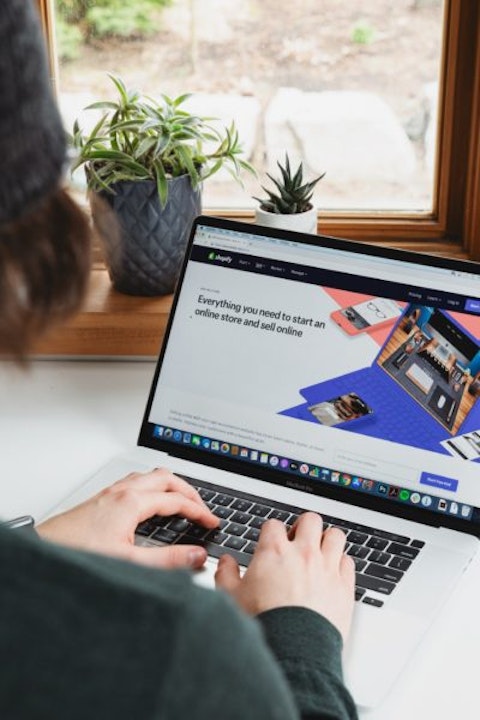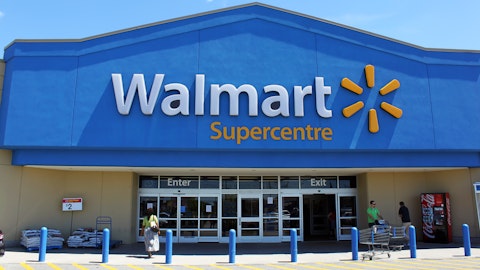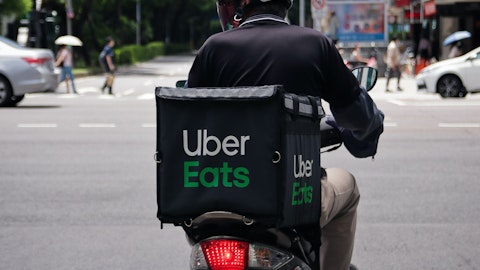Shopify Inc. (NYSE:SHOP) Q1 2023 Earnings Call Transcript May 4, 2023
Carrie Gillard: Good morning, and thank you for joining Shopify’s First Quarter 2023 Conference Call. Harley Finkelstein, Shopify’s President; and Jeff Hoffmeister, our CFO, are with us today. After their prepared remarks, we will open it up for your questions. We will make forward-looking statements on our call today that are based on assumptions, and therefore, subject to risks and uncertainties that could cause actual results to differ materially from those projected. We undertake no obligation to update these statements, except as required by law. You can read about these assumptions, risks and uncertainties in our press release this morning as well as in our filings with the U.S. and Canadian regulators. We’ll also speak to adjusted financial measures, which are non-GAAP and not a substitute for GAAP financial measures.
Reconciliations between the 2 are in the tables at the end of our press release. And finally, we report in U.S. dollars, so all amounts discussed today are in U.S. dollars unless otherwise indicated. With that, I will turn the call over to Harley.
Harley Finkelstein: Thanks, Carrie, and good morning, everyone. Before we jump into our Q1 performance, let me first touch on the announcements that we shared earlier this morning. We are changing the shape of Shopify significantly today. The decade we’re in shows the speed of change accelerating beyond what anyone has ever experienced. The pace of change can never outpace our ability to adapt. So today, we announced that we are reducing our head count and leaning into our partner model ecosystem, selling the majority of our logistics business to Flexport, who will become the preferred logistics partner for Shopify. For our team, this is an incredibly hard week. Shopify is a company that deeply values the talented builders that make it possible for Shopify to simplify operations that reduce friction and enable merchant success.
We would not be the company we are today without the work and the passion that our team puts in every day to pursue our mission. We also realized that in order to adapt and stay at the forefront of commerce, Shopify must operate with even greater speed and efficiency. So we are making changes and refocusing the priorities that we believe will get Shopify to the size and the shape necessary to unlock the next era of growth and innovation, but that does not make this earnings call any easier. I will be doing this call and then quickly turning back to internal matters. And Tobi will not be joining us on the call today as he insisted on focusing his time and attention on our team. On logistics, building logistics infrastructure is a side effort that all e-commerce entrepreneurs are eventually pulled into.
Shopify decided to take this on, on behalf of every merchant because we’re significantly larger and we can leverage our scale to build this on their behalf. Flexport has been a key partner throughout this journey. And given our long history of building direct integrations into powerful platforms, we believe that Flexport will be the best partner to carry this vision forward. And for our merchants, making it easier for them to access fast, reliable fulfillment from port to porch is a shared vision that Flexport will now take the lead on as our preferred logistics partner, led by world-class operators, CEO, Dave Clark and Founder Ryan Petersen, now with the leadership of Deliverr founder, Harish Abbott, this planned sale will enable Flexport to leverage their DNA in logistics and allow Shopify to focus on what we do best, designing and scaling a breadth of solutions and essential infrastructure that our merchants need to compete in an increasing digital world.
We know we have more work to do to achieve our goal of building a sustainable 100-year company. Our actions today should be evidence of our commitment to our mission, our merchants and our team to not just keep up, but to lead and to shape the future of commerce. With that said, I will now turn to our product and merchant developments for the quarter before Jeff discusses the financial results in more detail. This year has started off incredibly strong for Shopify and our merchants. In Q1, we continued to expand our merchant base with strong growth across all geographies and merchant sizes. We realized the incredible amount of trust our merchants have in Shopify, which is why we move quickly, so we can show up for our merchants consistently quarter after quarter, giving them the unified commerce solutions they need to run their business and focus on what matters most, their product and their customers.
Our strong Q1 performance is evidence of our ability to continuously adapt and anticipate their future needs at every turn. This is why merchants choose us. Let me start by discussing the progress and key accomplishments that we have made in our 3 core focus areas, which are centered around how we help merchants. First, expand from first sale to full scale; next, go global; and finally, build consumer relationships. Starting with how we think about expanding from first sale to full scale. On our last call, we talked about the launch of our enterprise retail solution, Commerce Components by Shopify or CCS. CCS is a modern composable stack where retailers can choose the Shopify components they want, integrate them with their existing systems and create incredible customer experiences using the same software and solutions that enabled Shopify to power over 10% of U.S. e-commerce.
Up until the release of CCS, there has been a scarcity of modern commerce solutions for enterprise retailers that can give brands the choice, flexibility and performance from a single enterprise offering. By making the best of Shopify, such as our world-class checkout and storefront available on an individual basis, CCS is kicking down the door to conversations with retailers that previously weren’t aware of the power and the versatility of Shopify. There is a perception shift happening in the marketplace as enterprises begin to realize that they are now able to combine Shopify’s cutting-edge commerce solutions with their existing infrastructure, all while optimizing their operating expenses. And we are seeing success with large recently signed enterprise brands like food delivery company, Daily Harvest; the iconic Canadian coffee house chain, Tim Hortons; U.K. fashion designer, Ted Baker; Japanese retailer, Yogibo, our largest outbound deal ever in Japan, a multi-brand deal with global retail brands in Australia; and American retail giant, Zulily, which is owned by QVC that actually came to Shopify from a referral from another very large enterprise merchant we have.
All of these incredible global brands are trusting Shopify to help them grow, scale and keep their business secure. A key part for our go-to-market strategy for enterprises will come from our system integrator partnerships. Early in Q1, we signed an agreement with IBM Consulting and entered agreement with Cognizant, which is over 350,000 employees generating over $19 billion in annual revenue in 2022. Of note, Cognizant did all of the Shopify-related implementation for premier consumer products customer. So we are thrilled to have them as a partner for future opportunities. We believe these partnerships will further our efforts to not only grow our merchant base, but also expand our offering with existing merchants. To truly enable first sale to full scale requires us to have infrastructure and capabilities to handle massive traffic volumes at any moment in time.

Photo by Roberto Cortese on Unsplash
For Shopify, we’ve set a new record in Q1. We hosted the highest throughput flash sale in our company’s history with Supreme’s February drop, which drove orders per minute that were equivalent to our Black Friday/Cyber Monday levels, a true testament to the scale, agility and the resilience of our platform. It also highlights how the investments we have been making over the past couple of years are strengthening our commerce operating platform to power any brand on the planet. Moving on to going global. One way we are driving greater penetration internationally is by making it easy for a merchant to sell globally as they do locally. During the quarter, approximately 15% of total GMV were cross-border as our primary products that were rolled out last year, Markets and Markets Pro, continue to gain traction.
Markets makes it simple to localize the buyer experience for each region a merchant sells to by enabling local currencies, which is a key determinant for consumers, offering local payment options and collecting duties and taxes at checkout to create total cost clarity. All of this can be customized in one place in the Shopify Admin with ease. When we layer on the functionality of the translate and adapt app for our merchants who use markets, our data showed meaningful improvements to conversion rates. Shopify Markets Pro, a fully integrated merchant of record solution is built on top of Markets. Markets Pro is a great option for merchants looking to scale to new markets quickly without having to navigate international tax compliance or fraud while tapping into best-in-class international shipping options with duties prepaid.
Our team has continued to make improvements to Markets Pro and is on track to fully roll out the product in the U.S. this summer and then to the U.K. later this year. We’ve seen considerable interest in Markets Pro and believe there’s a lot of opportunity for us with this product to further unlock our merchants’ ability to reach more consumers around the world. Finally, our third core area, building consumer relationships. One of Shopify’s strengths is our comprehensive suite of innovative, unified commerce solutions that enable brands to find, engage and build relationships with consumers across every surface. As commerce is increasingly showing up everywhere, advancing our full suite of commerce solutions to stay at the forefront of our merchants’ needs remains paramount for their success.
Point-of-Sale, the Shop App and Audiences are 3 areas where we continued to drive meaningful product enhancements in the quarter. Our Point-of-Sale solution continued to gain traction in Q1 with offline GMV increasing 31% year-over-year. We continue to expand both the functionality of our Point-of-Sale offering and its ability to handle the needs of retailers with a large number of physical locations. During the first quarter, top-tier apparel brands like Kit and Ace, which was started by the founder of Lululemon, launched our Point-of-Sale Pro solution for all of their stores. And another consumer favorite Gap brand, Banana Republic Home, is planning an omnichannel launch later this year with our Point-of-Sale Pro offering across their initial retail locations.
These are just 2 examples of the growing number of household name brands who are coming to Shopify for not only our online offering, but also our brick-and-mortar capabilities. Even as more and more large brands choose Shopify for our unified commerce capabilities, we remain the best commerce offering for SMBs. After Intuit made their decision to sunset their QuickBooks desktop Point-of-Sale product, they chose Shopify to be the preferred partner to migrate new retailers in need of a new Point-of-Sale solution. This partnership recognizes the depth and the quality of Shopify’s Point-of-Sale offering and opens up the funnel for more SMBs and mid-market retailers to join Shopify and leverage our suite of retail solutions. We’re already seeing traction from this partnership with thousands of new merchants having chosen to adopt Shopify Point-of-Sale.
Our Shop App is another incredible opportunity for our merchants. Back in February, as part of our winter edition release, we announced some of the biggest product updates to Shop since launching in 2020. We’re in the post-cookie mobile era of commerce, where brands are increasingly motivated to build their own mobile experiences to retain ownership of their customer relationships. But for most businesses, the technical and financial resources required to build and maintain their own mobile app just does not make sense. Today, Shop gives merchants an out-of-the-box mobile storefront, making it easy for them to leverage Shop’s existing buyer audience to drive new and repeat customers to their brand. And of course, when you layer on Shop Pay, which continues to be the best converting checkout on the Internet, Shop is becoming one of merchants’ most important channels.
Another example of how Shopify is staying at the cutting edge of commerce is the AI shopping assistant that Shop launched in March. Shoppers tell the assistant what they are looking for, and it serves up relevant product recommendations from Shopify merchants. It’s like having your own shopping concierge powered by ChatGPT, one of the most advanced technologies that we have seen in decades. We believe that we are in the early innings of unlocking the true power of AI, not only for our merchants and their customers, but also for Shopify. Moving to Audiences. Shopify Audiences continues to be a dynamic feature for our Plus merchants, helping drive top performance in paid advertising across meta, Google and Pinterest. The machine algorithm that powers Audiences is more effective than ever before.
In the year since the product first launched, we have shipped dozens of algorithm improvements as frequently as every 2 weeks. This constant experimentation has resulted in the average return ad spend merchants see on the platform to nearly double what it was originally. We don’t expect this trend to slow down. This performance is reflected in the product’s adoption. More merchants are using Shopify Audiences than ever before. In fact, our data suggests that Audiences is now a key reason merchants choose to upgrade to Plus, averaging just over a week from upgrade to install the product. As the number of merchants who use the product grows, the algorithm gets smarter, the flywheel moves a little faster and performance improves further, a positive feedback loop.
Powered by our scale and the merchant trust we’ve earned over many years, Audiences is a unique advantage only Shopify can offer. It’s an opportunity for independent merchants to join forces and help each other succeed. We could not be more excited by the trajectory of this young product. Stepping beyond are 3 core themes: I want to talk a little more about our merchants. Earlier, I shared some of the large enterprise wins. But that, of course, is just one portion of the success we are seeing. In this past quarter, Shopify welcomed numerous notable brands representing a broad spectrum of verticals within apparel and accessories, fashion forward clothing and denim manufacturer, 7 For All Mankind, footwear brand KEEN and backpack and accessory brand Herschel Supply, all launched with Shopify in Q1.
On the international front, Japanese watch brand, Seiko, Winemaker Pernod Ricard and watchmaker, Daniel Wellington, launched sites on Shopify this quarter. And earlier this week, Lululemon Studio, formerly known as Mirror, launched on Shopify. Celebrity brands continue to default Shopify to launch their businesses as well. In Q1, Mary-Kate and Ashley Olsen’s luxury fashion designer brand, The Row, John Legend’s Loved01 and Kendall Jenner’s award-winning 818 Tequila brand all launched on Shopify. In closing, Shopify continues to be the engine powering millions of merchants around the world. Our platform continues to expand, giving our merchants more of the solutions they need to run their businesses online, offline and everywhere in between.
We have worked hard to earn our merchants’ trust as Shopify continues to solve the industry’s biggest problems to make commerce better for everyone. And with that, let me turn the call over to Jeff.
Jeff Hoffmeister : Thanks, Harley. The investments we have made into building a powerful commerce operating system for merchants of all sizes have delivered strength across all elements of our business. Let’s dive into our Q1 results, starting with GMV. . GMV in Q1 was $50 billion, up 15% year-over-year or 18% on a constant currency basis as merchants delivered another strong quarter of growth. We achieved this GMV strength primarily through more resilient consumer spend, with strength in Europe being particularly notable, existing merchant same-store sales growth and growth in our merchant base. Revenue for the first quarter was $1.5 billion, up 25% year-over-year or 27% in constant currency, driven by the GMV strength just discussed, growth in our Merchant Solutions business led by payments penetration and growth in Subscription Solutions.
Our Q1 revenue came in better than our outlook, largely driven by the outperformance of GMV, strong growth across our Merchant Solutions product suite and strength in Europe from both consumer spend and more favorable exchange rates than anticipated. Our total attach rate, which is defined as revenue divided by GMV, is a key performance indicator of our business and our ability to generate greater value for our merchants. In Q1, our attach rate was 3.04%, up from 2.79% in Q1 2022. Merchants continue to buy more and more solutions from us, which speaks to both attraction of new products and the trust that merchants put in us. This represents the highest attach rate in our history. Moving to our revenue streams, starting with Merchant Solutions.
Q1 Merchant Solutions revenue was $1.1 billion, increasing 31% year-over-year or 33% on a constant currency basis, driven by the increase in GMV, continued penetration of Shopify Payments and the contribution from Deliverr. $27.5 billion of GMV was processed by Shopify Payments in the first quarter, 25% higher than in the first quarter of 2022. The penetration rate of Shopify Payments as a percentage of GMV was 56% for the quarter versus 51% in Q1 of the prior year. Several factors drove the quarter’s higher gross Payments volume, including the strong performance by those merchants utilizing Shopify Payments, an increasing percentage of which are Shopify Plus; new merchant adoption across the globe; greater penetration of Shop Pay; and continued growth of our integrated Point-of-Sale solution in physical retail stores.
Subscription Solutions revenue was $382 million, up 11% over Q1 of 2022, primarily due to growth in our Plus subscriptions. Moving to monthly recurring revenue, or MRR. Q1 MRR was $116 million, up 10% year-over-year. We saw strong growth across each of Plus, Standard and Point-of-Sale, with Plus being the largest contributor of growth in absolute dollars. Our Plus merchants, as a percentage of total MRR, increased to 34% from 30% in Q1 of 2022. Additionally, we are beginning to see the impact from the initial cohorts that were a part of our free and promotional trials that began to roll out broadly in October 2022. We saw these cohorts convert to full-priced Standard subscriptions starting in Q1, which contributed to the acceleration in MRR growth year-over-year and quarter-over-quarter.
The merchants comprising the initial cohorts from these trial experiments are demonstrating very positive results. The longer trial period has provided merchants a better onboarding experience, giving them additional time to experiment and familiarize themselves with our rich feature set and have more time to find the right product and market niche for their products. As a result of these trials, we are seeing higher weekly active sales and more merchants achieving their first sale on our platform, contributing to our GMV outperformance compared to the broader market. Separately, as previously announced in January, we introduced pricing changes to our standard subscription plans. The pricing changes had minimal impact on our Q1 financials as the full pricing changes did not take effect until about a week ago, but we anticipate that they will benefit our MRR growth more meaningfully in the second half of the year.
Gross profit was $717 million for the quarter, and gross margin was 47.5% in our first quarter. Compared to Q1 2022 gross margins of 53%, our gross margin this quarter was primarily affected by the dilutive impact of Deliverr. Additionally, Q1 gross margin was also impacted by Merchant Solutions being a larger percentage of our business, driven by growth in Shopify Payments. And within our Shopify Payments business, we continued to see gross margin pressure due to the greater mix of Plus and higher mix of credit cards versus debit cards compared to Q1 last year. Operating expenses were $910 million for the quarter. This represents a sequential increase of 1% over Q4 of 2022 operating expenses of approximately $903 million, when excluding the onetime charges from Q4 of $84 million.
Compared to Q1 of 2022, the primary drivers of this increase in operating expenses are related to higher compensation expense, including Deliverr. As we have demonstrated over the past 3 quarters, our operating expense dollars, excluding onetime items, continue to stabilize and grow at a much slower rate. This directly reflects our focus throughout the entire organization to drive increased productivity and efficiency across our teams. We continue to rigorously evaluate all of our cost, including greater scrutiny on our cloud infrastructure spend, return on our marketing programs and their associated payback periods, and in general, an increased internal utilization of automation and technology to replace manually driven processes. Let me share a specific example of what I mean.
In Q1, within sales and marketing, expenses declined both year-over-year and sequentially as we have been working to diversify our marketing mix over the past year. Prioritizing areas such as direct mail and audio, we’ve also optimized payback from established channels like digital search and display. As a result, in recent months, we have seen the payback period for our paid advertising improve by over 50%. There’s a cross-functional team in place that’s assessing the amount of value we can extract from different marketing channels as we continue to improve our paid advertising payback periods and realize even more value from each dollar we spend in this area. Stock-based compensation for Q1 was $135 million compared to $118 million for the same period a year ago, primarily driven by the higher headcount from Deliverr.
Adjusted operating loss for the quarter was $31 million. The decline compared to Q1 of 2022 was due to lower gross margins year-over-year and higher operating expenses, primarily driven from increased compensation expenses. Our Q1 adjusted operating loss came in better-than-expected due to stronger top line growth and lower-than-expected operating expenses. For the quarter, free cash flow was $86 million, representing 6% of revenue. You will hear us talk more frequently going forward about free cash flow, which we calculate as cash flow from operations minus CapEx. Turning quickly to our balance sheet. Our cash and marketable securities balance was $4.9 billion as of March 31. Before I get into our outlook, some additional information regarding the sale of our logistics businesses and Shopify reducing our head count.
As Harley mentioned, earlier today, we announced that we reached an agreement to sell our logistics business, including most of our SFN assets and Deliverr to our trusted partner, Flexport. In connection with the transaction, Shopify and Flexport intend to deepen their partnership with Flexport becoming our official logistics partner moving forward and providing Shopify merchants with fast and reliable logistics solutions. Shopify will continue to offer the merchant-facing SFN app, which provides merchants an integrated logistics experience through Shopify, powered by Flexport. Under the terms of the agreement, Shopify will receive stock representing a 13% equity interest in Flexport. When combined with our existing ownership, we will own a high-teens percentage in Flexport.
In connection with the closing of the sale, Shopify is entitled to name a director to Flexport’s Board. Today, we also announced that we are making changes to our organization, reducing our overall workforce by approximately 20%, excluding employees and our logistics businesses, some of which will move to Flexport and some of which will be part of the reduction in force. While this decision to reduce the size of our team was incredibly difficult, we are moving quickly towards the ideal shape and size that will enable us to build on our momentum and power the future of commerce. We believe that our business remains incredibly strong and our opportunities for sustainable long-term growth are abundant. Partnering with Flexport will allow us to focus on the areas where we as a team have the highest impact and had the most value for our merchants, helping them on some of their most critical challenges, including running and managing the business, selling wherever consumers are, discovering new customers and thriving at any stage in any market.
Keeping all this in mind, let’s turn to our outlook. We anticipate that the sale of our logistics businesses will happen towards the end of the second quarter, subject to certain conditions and regulatory approvals as applicable. And accordingly, that the majority of the financial impact of these transactions will not materialize until the second half of the year. Here are our expectations for the second quarter. First, on revenue. We expect our second quarter revenues to grow at a rate similar to our Q1 year-over-year growth rate. We anticipate that the pricing changes that just went into effect will be counterbalanced by the pending sale of our logistics businesses. Q2 gross margin percentage is expected to be similar to our Q1 gross margin percentage with the expected benefit from the pricing changes to be offset by the pending sale of our logistics business and the continued growth of Shopify Payments, which is a lower-margin business.
We believe that our Q2 operating expense dollars, excluding onetime items related to the pending sale of logistics and severance charges, will decrease a mid-single-digit percentage versus our Q1 operating expense dollars. Stock-based compensation is expected to be approximately $110 million. This excludes the onetime charges related to the sale of our logistics businesses. Finally, we expect free cash flow, which, as mentioned, we define as operating cash flow less CapEx, to be positive for each quarter of 2023. We, as a management team, are committed to profitability, and you will hear us talking more frequently regarding free cash flow. With the pending sale of our logistics business, obviously, our capital expenditures are going to be a lot lower going forward.
We currently expect to spend approximately $100 million for the full year of 2023, which includes 2 quarters of CapEx from logistics. Finally, specifically related to the announcements today, our current expectation is at Q2, we will incur $140 million to $150 million in severance from the workforce reduction and an impairment of $1 billion to $1.5 billion in the aggregate related to the various components of our logistics businesses. In closing, 2023 is off to a very strong start. Our financial outperformance reflects our merchants’ trust in Shopify’s mission-critical commerce operating system to not only run their business, but to grow it. Brands across the globe continue to turn to us for the incredibly rich feature set that we offer, which we believe continues to represent the most exceptional value in the marketplace today.
Our teams are adhering to rigorous operational discipline and cost control, while achieving greater productivity and efficiencies throughout the company. We are incredibly proud of what our team has accomplished so far this year and will continue to achieve throughout 2023. I’ll now turn the call back over to Carrie for any questions.
Brian Peterson : So I’m curious on the timing of the decision to sell the logistics business. Why now? And maybe how should we be thinking about any changes that you may have in kind of the build by partner decision about future growth initiatives?
Harley Finkelstein: Brian, Harley, I’ll take the question. Look, I think Shopify, unlike a lot of technology companies, we actually do partnerships really, really well. If you sort of go back, I don’t know, 8 or 9 years ago, so when we first decided to go into the payments business, we deeply partnered with Stripe and was able to go to market much faster with an incredible product. And that partnership obviously continues. We’ve done the same thing with companies like Affirm when we felt that they were doing buy now, pay later better than anyone else globally on the cross-border commerce side of things. So I mean, Shopify, going back to what you heard today and Tobi’s letter, but our main mission, our main quest versus side quest, we do something in the world better than anybody else, which is building commerce software.
And that’s what we want to be able to do. We want to focus on that. We want to execute on that. So when — as we began to build out the logistics business, which started about 4 or 5 years ago, remember at the time, there was no one else that was helping small businesses, medium-sized businesses with logistics and shipping. And so even though we knew it was going to be an incubation period for us, we felt there was no one else doing it and better for us to do it than for our merchants to do it. As things progress and we began to further and more deeply integrate with Flexport with Dave and Ryan and the team, it became clear that, that is their main quest. They are so focused on creating logistics and shipping infrastructure for small and medium-sized businesses.
And this way, we get product acceleration, and we can focus on what we do best, they can focus what they do best. But again, I think we’re a company that has proven that when we can build something better than anyone else, we do it, and we’ve done that across a whole bunch of different areas of our business. But when there’s a partner that we can deeply integrate with that can get us further faster and more efficiently, we will do that, too. And that was the case here.
See also 12 Most Profitable Gold Stocks and 16 Best Places to Live in Texas.
Q&A Session
Follow Shopify Inc. (NYSE:SHOP)
Follow Shopify Inc. (NYSE:SHOP)
Carrie Gillard: Our next question will come from Josh Beck at KeyBanc.
Josh Beck: Are you able to hear me?
Carrie Gillard: Yes, we can hear you.
Josh Beck: Yes. Sorry about that. I wanted to ask just a little bit about kind of the second half of the year and how we should obviously think about the cadence of OpEx. You obviously gave us some very helpful color around how to contemplate Q2. Should we be really thinking about that as a partial quarter reflecting the new kind of workforce footprint so as we go into Q3 and Q4, it could be a little bit different. And any other color you can provide there would be great.
Jeff Hoffmeister: Yes. This is Jeff. I’ll start on that. You’re right, as it relates to timing, we mentioned that the transaction with Flexport would close. We expect it to close in Q2. There are some regulatory processes we need to go through, most likely here. We don’t know, obviously, therefore, exactly when it will close. Our estimates for Q2 as we gave in guidance reflect a closing in that transaction with Flexport towards the latter half of the quarter. And yes, obviously, it’s — we’re a month into the quarter when we’re making this announcement today regarding our employee head count. So Q2 will not be what you would call “normalized quarter.” When we get to our quarterly results next quarter, we’ll obviously be able to give you some more guidance. But I think your general sentiment that this is kind of a partial impact that you’ll see in this quarter is accurate.
Carrie Gillard: Our next question will come from Paul Treiber at Barclays.
Paul Treiber: Just a question on the transaction with Flexport. The letter mentioned that Shopify would — or Flexport would be the preferred partner for logistics. Does that preferred partner mean exclusive partner? Or would like Payments, you would support other third-party logistics providers on Shopify?
Harley Finkelstein: Paul, yes, that’s right. Look, we have millions of stores in the platform. We have lots of small businesses. We also have very, very large enterprises as well. Part of our role is being the centralized operating system for these millions of businesses and brands, is to enable them to bring the best products, the best infrastructure that they need to run their business. So Flexport is going to be the preferred partner. We think what they’re doing is exceptional. And as I mentioned earlier, any business that grows at some point, there’s sort of this massive floodlight eventually that shines on them on one of the most complex issues, which is that of logistics, and they’re going to do a great job there. They’ve already proven to us they know what to do there.
But if there is a particular logistics partner or shipping company that another merchant wants to bring along, we can integrate with that, and we have been doing that for quite some time with our shipping APIs.
Carrie Gillard: Our next question will come from Deepak Mathivanan at Wolfe Research.
Deepak Mathivanan: So Jeff, after these cost-saving initiatives that you’re currently implementing, how should we think about the fixed cost growth beyond into second half and 2024? Do you feel like headcount and other fixed costs are right now at the right place with this restructuring for sort of medium-term opportunities companies see? And maybe is there a margin target or perhaps maybe relative to what you did before that we can expect going forward?
Jeff Hoffmeister: Yes. Well, as I alluded to just a couple of questions ago, as it relates to our operating expense levels, we gave you some guidance as it relates to Q2, that will still be in flux. As it relates to gross margin, I guess what I would say, obviously, when you think about my comments about when the Flexport transaction will close, when you look at Q2, we will have partial impact from Flexport — or I’m sorry, from Deliverr, which historically has obviously been a headwind to margins. We do have the pricing increases going into effect in Q2. Obviously, basically about a week or so when those started hitting our P&L. So that will be counterbalancing for us in there. But obviously, Shopify Payments, as that is a larger and larger mix of revenues, that, of course, has an impact on gross margins in the opposite direction.
So as we think about where we are for gross margins, we gave you guidance for Q2 to basically be in line with Q1. Obviously, Q1 is up over Q4. In Q4, you may recall, we were at 46%. So we’ve got some forces moving in both directions on gross margins. We’re obviously not ready at this point to comment on the full year. But I think it’s going to be a lot of the trends that you’ve seen historically on the business.
Carrie Gillard: Our next question will come from Colin Sebastian at Baird.





